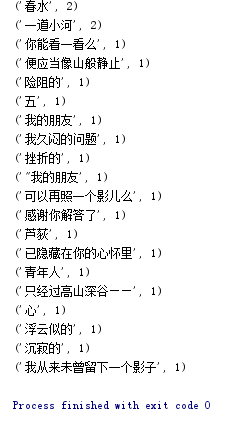@Required注解
@Required注解用于setter方法,表明这个属性是必要的,不可少的,必须注入值
假设有个测试类,里面有name和password两个属性
我给两个属性的setter方法都加了@Required注解
package com.example.demo1.Implements; import com.example.demo1.Interface.UserService; import org.springframework.beans.factory.annotation.Required; public class UserClientImpl implements UserService { private String name; private String password; public UserClientImpl(){} public UserClientImpl(String name,String password){ this.name = name; this.password = password; } public String getName() { return name; } @Required public void setName(String name) { this.name = name; } public String getPassword() { return password; } @Required public void setPassword(String password) { this.password = password; } @Override public void save() { System.out.println("客户端保存信息"+name+"--"+password); } }
现在我只给一个属性加注入,另一个不加
可以看到报错

然后我补上注入之后就没问题了

@Autowoired注解
其实看名字就可以看出来,这个是跟自动装填有关
使用它需要加一行代码
<bean class="org.springframework.beans.factory.annotation.AutowiredAnnotationBeanPostProcess></bean>
1,在属性前加此注解
先给定两个类
package com.example.demo1.Other; public class CustomerTest { public CustomerTest(){ System.out.println("在Customer.构造方法中..."); } public void show(){ System.out.println("在Customer.show方法中..."); } }
package com.example.demo1.Implements; import com.example.demo1.Interface.Customer; import com.example.demo1.Other.CustomerTest; import org.springframework.beans.factory.annotation.Autowired; public class CustomerImpl implements Customer { private String name; private String id; @Autowired private CustomerTest customerTest; public CustomerTest getCustomerTest() { return customerTest; } public void setCustomerTest(CustomerTest customerTest) { this.customerTest = customerTest; } public String getName() { return name; } public void setName(String name) { this.name = name; } public String getId() { return id; } public void setId(String id) { this.id = id; } @Override public void show() { System.out.println(id+"..."+name); customerTest.show(); } }
第二个类在第三个成员变量前面加个此注解
然后applicationContext这样写
<bean id="Customer" class="com.example.demo1.Implements.CustomerImpl"> </bean> <bean id="CustomerTest" class="com.example.demo1.Other.CustomerTest"></bean>
在打印一下结果
ApplicationContext instance = new ClassPathXmlApplicationContext("applicationContext.xml"); CustomerImpl customer = (CustomerImpl) instance.getBean("Customer"); customer.show(); ((ClassPathXmlApplicationContext) instance).registerShutdownHook();
 可以看到Customer对象是自动装填了的
可以看到Customer对象是自动装填了的
2,在构造函数之前加此注解
效果和上面是一样的,不演示了
3,@Autowired(required=false)的作用
这里跟之前的@Required的作用类似
默认情况下,@Autowired 注释意味着依赖是必须的,它类似于 @Required 注释,然而,你可以使用 @Autowired 的 (required=false) 选项关闭默认行为。
这里跟@Required的效果类似,不演示了
@Qualifier注解
在之前的学习注解的过程中,显然,用自动装配的时候,如果配置的bean是相同的类的生成的对象,会报错,于是为了解决这个问题,@Qualifier就出来了
@Qualifier和@Autowired一起使用,在@Qualifier后面的括号里欲装配的bean的名称,就可以让Spring自动给我们装配合适的bean
首先applicationContext.xml ,因为要用到context标签,需要用到aop.jar,所以在这之前记得引入Springframework-aop.jar,这个标签就像之前的注解一样,需要注册那几个Processor才能起作用
<?xml version = "1.0" encoding="UTF-8" ?> <beans xmlns="http://www.springframework.org/schema/beans" xmlns:xsi="http://www.w3.org/2001/XMLSchema-instance" xmlns:context="http://www.springframework.org/schema/context" xsi:schemaLocation="http://www.springframework.org/schema/beans http://www.springframework.org/schema/beans/spring-beans-3.0.xsd http://www.springframework.org/schema/context http://www.springframework.org/schema/context/spring-context-3.0.xsd"> <context:annotation-config/> <bean id="Profile" class="com.example.demo1.Testclass.Profile"></bean> <bean id="student1" class="com.example.demo1.Testclass.Student"> <property name="name" value="student1"></property> <property name="age" value="2"></property> </bean> <bean id="student2" class="com.example.demo1.Testclass.Student"> <property name="age" value="3"></property> <property name="name" value="student2"></property> </bean> </beans>
注解是放在要装配放属性的上方
package com.example.demo1.Testclass; import org.springframework.beans.factory.annotation.Autowired; import org.springframework.beans.factory.annotation.Qualifier; public class Profile { @Autowired @Qualifier(value = "student1") private Student student; public Profile(){ System.out.println("Inside Profile constructor." ); } public void setStudent(Student student) { this.student = student; } public void printAge() { System.out.println("Age : " + student.getAge() ); } public void printName() { System.out.println("Name : " + student.getName() ); } }
package com.example.demo1.Testclass; public class Student { private Integer age; private String name; public void setAge(Integer age) { this.age = age; } public Integer getAge() { return age; } public void setName(String name) { this.name = name; } public String getName() { return name; } }
之后Spring就会识别出合适的bean并注入了
测试代码
ApplicationContext instance = new ClassPathXmlApplicationContext("applicationContext.xml"); Profile profile = (Profile) instance.getBean("Profile"); profile.printName(); ((ClassPathXmlApplicationContext) instance).registerShutdownHook();
结果也正是这样


![[Vue] 14.Vue中的组件:创建子组件以及在父组件中用子组件](https://img-blog.csdnimg.cn/a7d888f26b264faabd7249f8cf1908eb.png)



![[Vue] 15.Vue中的组件:组件传值及传值校验](https://img-blog.csdnimg.cn/97bff9ce6ed34ca2833675e008ea0198.png)

